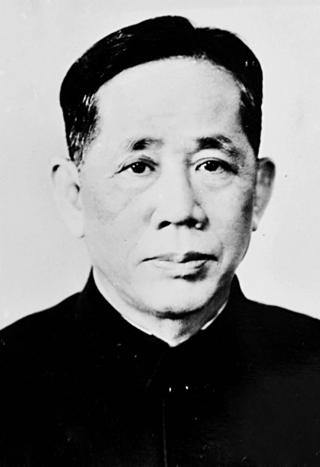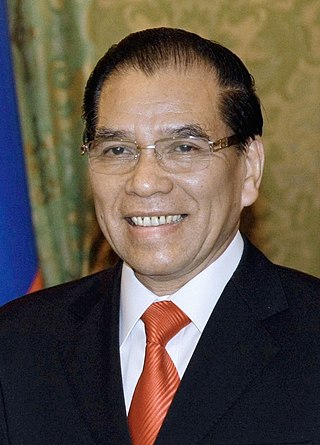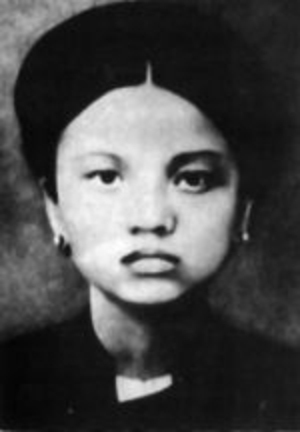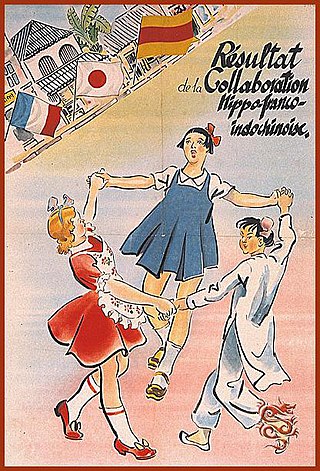Related Research Articles

Hồ Chí Minh, commonly known as Uncle Ho, President Ho and by other aliases and sobriquets, was a Vietnamese revolutionary and statesman. He served as Prime Minister of the Democratic Republic of Vietnam from 1945 to 1955, and as President from 1945 until his death in 1969. Ideologically a Marxist–Leninist, he was the Chairman and First Secretary of the Workers' Party of Vietnam.

Lê Duẩn was a Vietnamese communist politician. He rose in the party hierarchy in the late 1950s and became General Secretary of the Central Committee of the Communist Party of Vietnam (VCP) at the 3rd National Congress in 1960. He continued Hồ Chí Minh's policy of ruling through collective leadership. From the mid-1960s until his own death in 1986, he was the top decision-maker in Vietnam.

Phạm Văn Đồng was a Vietnamese politician who served as Prime Minister of North Vietnam from 1955 to 1976. He later served as Prime Minister of Vietnam following reunification of North and South Vietnam from 1976 until he retired in 1987 under the rule of Lê Duẩn and Nguyễn Văn Linh. He was considered one of Hồ Chí Minh's closest lieutenants.

Nông Đức Mạnh is a Vietnamese politician who served as General Secretary of the Communist Party of Vietnam, the most powerful position in the Socialist Republic of Vietnam, from 22 April 2001 to 19 January 2011. His parents were Tày peasants. Nông Đức Mạnh was born in Cường Lợi, Na Rì District, Bắc Kạn Province. His own son is Nông Quốc Tuấn, party secretary for Bắc Giang Province.

The First Indochina War began in French Indochina from 19 December 1946 to 20 July 1954 between France and Việt Minh, and their respective allies. Việt Minh was led by Võ Nguyên Giáp and Hồ Chí Minh. Most of the fighting took place in Tonkin in Northern Vietnam, although the conflict engulfed the entire country and also extended into the neighboring French Indochina protectorates of Laos and Cambodia.

The Communist Party of Vietnam (CPV), also known as the Vietnamese Communist Party (VCP), is the founding and sole legal party of the Socialist Republic of Vietnam. Founded in 1930 by Hồ Chí Minh, the CPV became the ruling party of North Vietnam in 1954 and then all of Vietnam after the collapse of the South Vietnamese government following the Fall of Saigon in 1975. Although it nominally exists alongside the Vietnamese Fatherland Front, it maintains a unitary government and has centralized control over the state, military, and media. The supremacy of the CPV is guaranteed by Article 4 of the national constitution. The Vietnamese public generally refer to the CPV as simply "the Party" or "our Party".

The August Revolution, also known as the August General Uprising, was a revolution launched by the Việt Minh against the Empire of Vietnam and the Empire of Japan in the latter half of August 1945. The Việt Minh, led by the Indochinese Communist Party, was created in 1941 and designed to appeal to a wider population than the communists could command.

Trường Chinh was a Vietnamese communist political leader and theoretician. He was one of the key figures of Vietnamese politics. He played a major role in the anti-French colonialism movement and finally after decades of protracted war in Vietnam, the Vietnamese defeated the colonial power. He was the think-tank of the Communist Party who determined the direction of the communist movement, particularly in the anti-French colonialism movement. After the declaration of independence in September 1945, Trường Chinh played an important role in shaping the politics of the Democratic Republic of Vietnam (DRV) and creating the socialist structure of the new Vietnam.
Zhang FakuiCBE was a Chinese Nationalist general who fought against northern warlords, the Imperial Japanese Army and Chinese Communist forces in his military career. He served as commander-in-chief of the 8th Army Group and commander-in-chief of NRA ground force before retiring in Hong Kong in 1949.

Zeng Xueming, known in Vietnamese as Tăng Tuyết Minh, was a Chinese midwife. She was a Catholic from Guangzhou and it was claimed that she married Nguyễn Ái Quốc in October 1926. They lived together until April 1927, when Hồ fled China following an anti-communist coup. Despite several attempts to renew contact by both Zeng and Hồ, the couple never reunited. Zeng and Hồ were never legally divorced, nor was their marriage ever annulled. There is uncertainty of true happenings as some say it was a marriage of convenience to avoid Hồ's political persecution during his time in Kuomintang-ruled China, whilst others say the story was never true to begin with, and was only a hypothesis.

North Vietnam, officially the Democratic Republic of Vietnam, was a socialist state in Southeast Asia that existed from 1945 to 1976, with formal sovereignty being fully recognized in 1954. A member of the Eastern Bloc, it opposed the French-backed State of Vietnam and later the Western-allied Republic of Vietnam. North Vietnam emerged victorious over South Vietnam in 1975 and ceased to exist the following year when it unified with the south to become the current Socialist Republic of Vietnam.

The 1945-46 War in Vietnam, codenamed Operation Masterdom by the British, and also known as the Southern Resistance War by the Vietnamese, was a post–World War II armed conflict involving a largely British-Indian and French task force and Japanese troops from the Southern Expeditionary Army Group, versus the Vietnamese communist movement, the Viet Minh, for control of the southern half of the country, after the unconditional Japanese surrender.

Nguyễn Thị Minh Khai was a Vietnamese revolutionary and a leader of the Indochinese Communist Party during the 1930s.

In mid-1940, Nazi Germany rapidly defeated the French Third Republic, and the colonial administration of French Indochina passed to the French State. Many concessions were granted to the Nazi-allied Empire of Japan, such as the use of ports, airfields, and railroads. Japanese troops first entered parts of Indochina the following September, and by July 1941 Japan had extended its control over the whole of French Indochina. The United States, concerned by Japanese expansion, started putting embargoes on exports of steel and oil to Japan from July 1940. The desire to escape these embargoes and to become self-sufficient in resources ultimately contributed to Japan's decision to attack on December 7, 1941, the British Empire and simultaneously the USA. This led to the USA declaring war against Japan on December 8, 1941. The US then joined the side of the British Empire, at war with Germany since 1939, and its existing allies in the fight against the Axis powers.
The Communist League of Indochina was one of the three communist groups of 1929–1930 which formed the base of the Communist Party of Vietnam in Vietnam, and within colonial French Indochina. It was formerly the Tân Việt Cách mệnh Đảng as well as the "Restoration Society" between 1925–1930.
The New Vietnam Revolutionary Party or Revolutionary Party of the New Vietnam 1925-1930, was a non-communist revolutionary party in Vietnam's early independence movement founded by Nguyễn Thị Minh Khai.
Ho Chi Minh Thought is a political philosophy that builds upon Marxism–Leninism and the ideology of Vietnamese revolutionary Ho Chi Minh. It was developed and codified by the Communist Party of Vietnam and formalised in 1991. The term is used to cover political theories and policies considered as representing a form of Marxism–Leninism that has been adapted to Vietnamese circumstances and history. The ideology includes views on the basic issues of the Vietnamese Revolution, specifically the development and application of Marxism–Leninism to the material conditions of Vietnam.

1940—1946 in French Indochina focuses on events that happened in French Indochina during and after World War II and which influenced the eventual decision for military intervention by the United States in the Vietnam War. French Indochina in the 1940s was divided into four protectorates and one colony (Cochinchina). The latter three territorial divisions made up Vietnam. In 1940, the French controlled 23 million Vietnamese with 12,000 French soldiers, about 40,000 Vietnamese soldiers, and the Sûreté, a powerful police force. At that time, the U.S. had little interest in Vietnam or French Indochina as a whole. Fewer than 100 Americans, mostly missionaries, lived in Vietnam and U.S. government representation consisted of one consul resident in Saigon.

1947–1950 in French Indochina focuses on events influencing the eventual decision for military intervention by the United States in the First Indochina War. In 1947, France still ruled Indochina as a colonial power, conceding little real political power to Vietnamese nationalists. French Indochina was divided into five protectorates: Cambodia, Laos, Tonkin, Annam, and Cochinchina. The latter three made up Vietnam.

The Haiphong Incident or the Haiphong Massacre occurred on November 23, 1946, when the French cruiser Suffren and several avisos bombarded the Vietnamese coastal city of Haiphong, killing some 6,000 Vietnamese people. The incident, also known as the Shelling of Haiphong, is thought of as the first armed clash in a series of events that would lead to the Battle of Hanoi on December 19, 1946, and with it the official outbreak of the First Indochina War.
References
- 1 2 ""Ho Chi Minh" by William J. Duiker". Salon.com . November 14, 2000. Retrieved December 3, 2010.
- ↑ "Increased trade could shift US". The Daily Collegian . January 26, 1984.
- ↑ Sherman, Christine (April 30, 2000). "Vietnam: 25 Years". The Press of Atlantic City .
- ↑ "Ho Chi Minh". 2000.